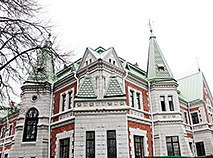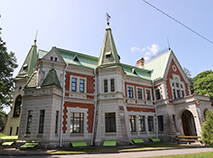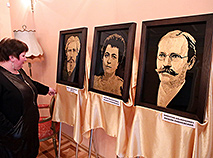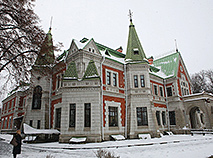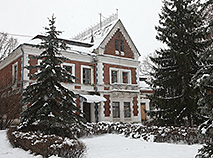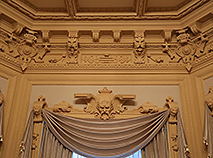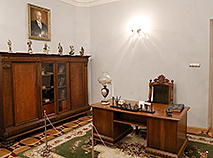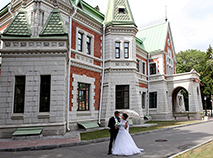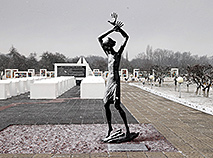Koziell Poklewski Estate in Krasny Bereg
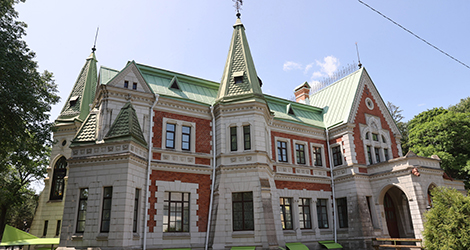
Koziell Poklewski Estate, perhaps the most unusual estate in Belarus, is located in a picturesque place near Zhlobin. Surrounded by an English garden, the estate decorated with gargoyles-chimeras on the roof above the entrance looks like a set staged for a fantasy film. The palace looks bizarre and very uncommon for Eastern Europe.
History
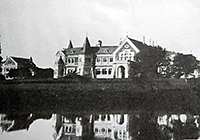
Krasny Bereg is located 25km north-west of Zhlobin. The place has been known since 1528 when the landowner Aleksei Zenkovich sold his property to another landowner. The village changed hands, until in 1877 it became the property of military engineer Mikhail Gatovsky. Four years earlier, the first train from Bobruisk to Gomel passed through the Krasny Bereg railway station.
Although the Gatovsky family lived most of the time in St. Petersburg, the lieutenant general wanted to build something unusual in his estate in Bobruisk District. The construction of the estate began on the bank of the Dobosna, a tributary of the Dnieper River, in 1890. The project of the estate was developed by architect Victor Schröter from St. Petersburg. Mikhail Gatovsky wanted the palace built in the shape of the letter "G" - in honor of the family name.
To finance the construction, the family took out a bank loan, which they repaid in three years, possibly with the help of Mikhail Gatovsky's son-in-law Wikientij Koziell Poklewski. At his request, a family coat of arms was placed above the main entrance of the manor house. Simultaneously with the construction of the palace, the work was in progress on an English garden designed by Warsaw’s chief gardener Franciszek Szanior.
After the death of Mikhail Gatovsky in 1904, the Krasny Bereg estate was not sold to another owner but was inherited by Mikhail Gatovsky’s daughter Maria. Her husband Wikientij Koziell Poklewski got himself busy with the affairs of the estate.
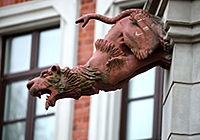
The manor house - the central element of the complex - is a G-shaped two-storey building. It is difficult to determine its architectural style. The building looks like it came off the pages of a fantasy novel. It combines almost a dozen different trends - Gothic and Romanesque, Rococo and Mannerism, Baroque and Classicism…Moreover, the estate in Krasny Bereg is the only one in Belarus that has traits of the neo-Mauritanian style. Red-brick walls, stained-glass arched windows, gargoyles, green-tiled turrets, mansard roofs, stucco, and painted ceilings – all these features can be seen in one building. Interestingly, the interiors of all 36 rooms of the building were designed in different styles.
In addition to the estate, the complex had an outhouse for servants, a distillery, a sawmill, a brewery, stables, an icehouse, and warehouses. They also incorporated elements of different styles.
A beautiful English garden was planted next to the house. It is fenced with an original wall on two sides and has a river on the third side. It has trees that are quite rare for Belarus: fir, red spruce, large-leaved linden, hornbeam, larch, velvety maple, etc.
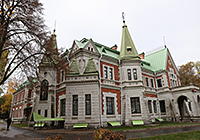
After the events of 1917, the estate in Krasny Bereg was nationalized. Three years later, the estate was re-purposed to house an agricultural school after agricultural schools in Ozarichi and Bobruisk were closed. Students studied in the main building, while the outbuildings were transformed into a hostel, workshops and a warehouse. The former owners left the estate never to return to Krasny Bereg.
The Great Patriotic War was a nightmare for the village. During the Nazi occupation it was turned into a large transit hub. There was a concentration camp here where children were forced to donate blood to Wehrmacht. The estate was used as a hospital – first to treat Germans, then Soviets. Thanks to this, the building and its interiors survived those terrible years.
Koziell Poklewski Estate today
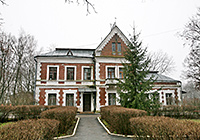
There is still an agricultural college on the premises of the estate, as the inscription on the 19th century entrance gate reads. However, the college moved to other buildings that were erected here in the late 20th century. The gate with octagonal turrets, the master’s house, the outbuilding, the stable, the brewery, the brick fence and the English garden have survived to this very day.
A restoration project was undertaken at the estate in 1996-2015. Now the palace houses a branch of the Zhlobin Local History Museum. The permanent exposition displays items and documents that chronicle the family history of the owners and the history of the estate, explain the architectural features of the complex and give a glimpse of the life and traditions of the nobility of the 19th century.
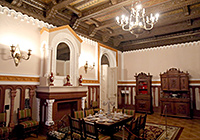
The estate and the surrounding park are included in the list of historical and cultural heritage of Belarus and are protected by the state. This part of Krasny Bereg makes it into the Golden Ring of Gomel Oblast tourist route.
How to get to Krasny Bereg and where to stay
The agro-town Krasny Bereg is located in Zhlobin District, Gomel Oblast. Visitors from Minsk can use the M5 highway to reach Krasny Bereg by car. Visitors from Zhlobin can either catch a bus or a shuttle bus to get to the agro-town or reach it by car.
Address: 14 Isayeva Street, the agro-town of Krasny Bereg, Zhlobin District, Gomel Oblast
Coordinates: 52.965341, 29.784220
It might also be a good idea to stop in Zhlobin or Minsk and come visit Krasny Bereg for a day.
Places of interest near the Koziell Poklewski Estate
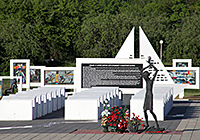
Just 1km away from the estate in the middle of an apple orchard there is a heartbreaking monument dedicated to children - victims of war. The memorial is a reminder of the horrible events that took place in Krasny Bereg almost 80 years ago. It was almost the site where there was a children's concentration camp during the Great Patriotic War. Girls and boys from eight to fourteen years of age were brought there by force to become unwilling blood donors for the wounded soldiers of the Wehrmacht. Those who survived the barbaric procedure were sent to Germany. Almost two thousand children went through this hell.
The memorial was opened in 2007. It was designed by architect Leonid Levin, one of the designers of the Khatyn complex.
The composition opens with a bronze sculpture of a girl with raised hands in a vain attempt to defend herself. Behind her back there is an empty school classroom of 21 snow-white desks and a blackboard with a letter of a camp prisoner to her father. On the back of the blackboard is a map of Belarus with 16 concentration camps where children were held. Nearby is a white boat of hope with the names of the children from the camp on both sides of its sails. More than two dozen “easels” with children's drawings and plasticine figures, in the form of stained glass and bronze sculptures, complete the composition - these are the works of students of an art studio of the Minsk Palace of Pioneers and students of the Krasny Bereg orphanage.
On the bank of the Dobosna River, 30 km north of Krasny Bereg, is the agro-town of Zhilichi. It is home to one of Belarus’ largest estates - Bulgakov Palace, built in the first half of the 19th century.


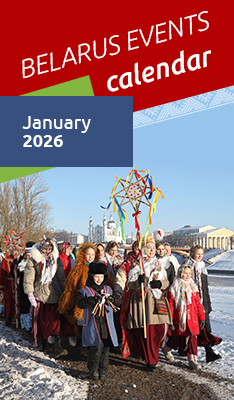




 print version
print version make home page
make home page add to bookmarks
add to bookmarks